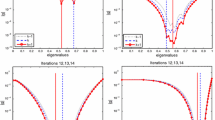Abstract
Newton-Raphson iteration provides a high-speed method for performing division. The Newton-Raphson division algorithm begins with an initial approximation to the reciprocal of the divisor. This value is iteratively refined until a specified accuracy is achieved. In this paper, we develop methods for selecting constant and linear approximations which minimize the maximum absolute error of the final result. These approximations are compared with previous methods which minimize the maximum relative error in the final result or the maximum absolute error in the initial value.
Zusammenfassung
Die Newton-Raphson Iteration, die eine schnelle Division gestattet, beginnt mit einer Anfangsnäherung für den Kehrwert des Divisors. Dieser Wert wird iterativ verbessert, bis die vorgegebene Genauigkeit erreicht ist. In der Arbeit wird die Auswahl von konstanten und linearen Näherungen beschrieben, die den maximalen Absolutfehler des Endergebnisses minimieren. Diese Näherungen werden mit vorliegenden Verfahren verglichen, bei denen der maximale Relativfehler im Endergebnis oder der maximale Absolutfehler der Anfangsnäherung minimiert wird.
Similar content being viewed by others
References
Flynn, M. J.: On division by functional iterations. IEEE Trans. Comput. C-19, 702–706 (1970).
Fowlder, D. L., Smith, J. E.: An accurate, high speed implementation of division by reciprocal approximation. Proceedings of the Ninth Symposium on Computer Arithmetic, pp. 60–67 (1989).
Alverson, R.: Integer division using reciprocals. Proceedings of the Tenth Symposium on Computer Arithmetic, 186–190 (1991).
Intel, i860 64-Bit microprocessor programmer's reference manual (1989).
Monotoye, R., Hokenek, E., Runyon, S.: Design of the IBM RISC System/6000 floating point execution unit,” IBM J. Res. Dev.34, 59–70 (1990).
Matula, D. W.: A highly parallel arithmetic unit for floating point multiply, divide with remainder and square root with remainder, SCAN-89, Basel October 1989.
Anderson, S. F., Earle, J. G., Goldschmidt, R. E., Powers, D. M.: The IBM System 360 model 91: floating point execution unit. IBM J. Res. Dev.11, 34–53 (1967).
Ferrari, D.: A division method using a parallel multiplier. IEEE Trans. Electr. Comput.EC-16, 224–226 (1967).
Das Sarma, D., Matula, D. W.: Measuring the accuracy of ROM reciprocal tables. Proceedings of the Eleventh Symposium on Computer Arithmetic, pp. 95–102 (1993).
Swartzlander, Jr. E. E.: Overview of computer arithmetic. Comput. Arith.2, IEEE Computer Press Society, pp. 1–14 (1990).
Parker, A., Hamblen, J. O.: Optimal value for the Newton-Raphson division algorithm. Inf. Proc. Lett.42, 141–144 (1992).
Anderson, N.: Minimum relative error approximations for 1/t. Numer. Math.54, 117–125 (1988).
Montuschi, P., Messalama, M.: Optimal absolute error starting value for Newton-Raphson calculation of square root. Computing46, 67–86 (1991).
Moursund, D. G.: Optimal starting values for Newton-Raphson calculation of\(\sqrt x \). Comm. ACM10, 430–432 (1967).
Author information
Authors and Affiliations
Rights and permissions
About this article
Cite this article
Schulte, M.J., Omar, J. & Swartzlander, E.E. Optimal initial approximations for the Newton-Raphson division algorithm. Computing 53, 233–242 (1994). https://doi.org/10.1007/BF02307376
Received:
Revised:
Issue Date:
DOI: https://doi.org/10.1007/BF02307376




